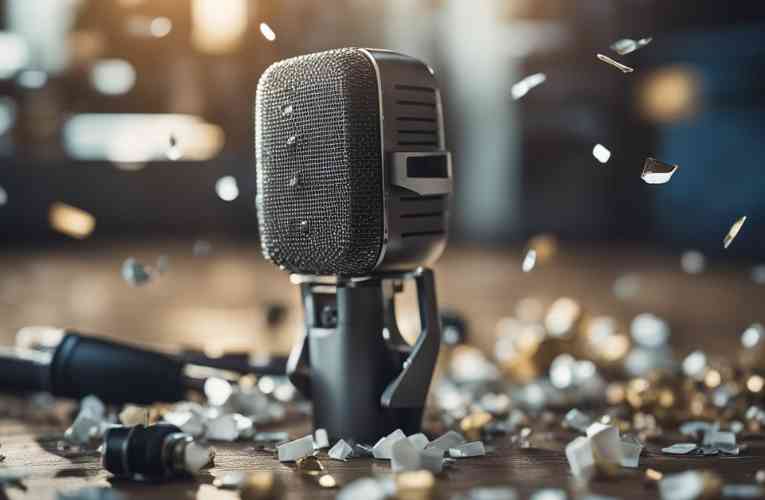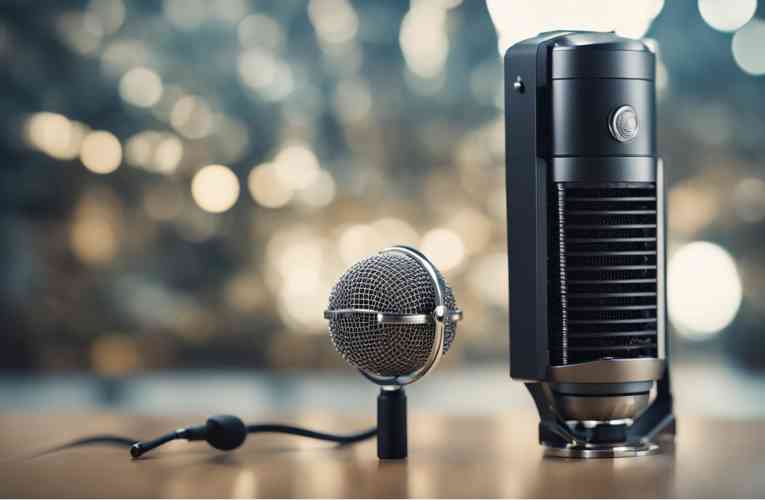Do condenser mics break easily? If you’re a musician or sound engineer, you’ve probably asked yourself this question at some point. Condenser microphones are widely used in the music industry, but they’re also known for being delicate and fragile.
In this article, we’ll explore the durability factors of condenser mics, common issues and troubleshooting, and how to optimize the longevity of your mic.
Table of Contents
ToggleDo Condenser Mics Break Easily?

Condenser mics are known for their superior sound quality, but they are also known for being fragile and delicate. While they may not necessarily break easily, they do require proper handling and care to avoid damage.
Condenser mics are more susceptible to damage than dynamic mics due to their internal preamp, which is made up of delicate circuitry. This circuitry is susceptible to corrosion, wear and tear, rust, water, and high voltage.
To avoid damaging your condenser mic, here are a few tips:
- Store your mic in a protective case when not in use
- Avoid exposing the mic to extreme temperatures or humidity
- Use a shock mount to protect the mic from physical vibrations
- Use a pop filter to protect the mic from saliva and other debris
- Handle the mic gently and avoid dropping it
By taking these precautions, you can help ensure that your condenser mic lasts for years to come.
Understanding Condenser Microphones
Condenser microphones are a popular choice for recording studios, podcasters, and content creators due to their sensitivity and ability to capture detail. They are generally more expensive than dynamic microphones, but they offer a higher level of accuracy and clarity.
Types of Condenser Microphones
There are two main types of condenser microphones: large-diaphragm and small-diaphragm. Large-diaphragm microphones have a diaphragm that is at least one inch in diameter, while small-diaphragm microphones have a diaphragm that is less than one inch in diameter.
Large-diaphragm microphones are commonly used for recording vocals, as they provide a warm and rich sound.
They are also suitable for recording acoustic guitars and other instruments that require a full-bodied sound. Small-diaphragm microphones, on the other hand, are typically used for recording instruments that produce high-frequency sounds, such as cymbals and violins. They provide a more detailed and accurate sound, but they can be less forgiving if the microphone placement is not precise.
How Condenser Microphones Work
Condenser microphones work by using a capacitor to convert sound waves into an electrical signal. The capacitor consists of two plates: a stationary backplate and a movable diaphragm. When sound waves hit the diaphragm, it vibrates, causing the distance between the two plates to change.
This change in distance causes a change in capacitance, which is then converted into an electrical signal by the microphone’s preamp.
Condenser microphones require a power source to operate, which is typically provided by an external phantom power supply or through the microphone cable itself (known as “phantom power”). This power source is necessary to charge the capacitor and maintain a constant voltage across it.
Related Posts:
Durability Factors of Condenser Mics

When it comes to durability, condenser microphones are often considered more fragile than dynamic microphones. However, the durability of a condenser microphone depends on several factors.
Build Quality
The build quality of a condenser microphone is a crucial factor in determining its durability. High-end condenser microphones are constructed with high-quality materials and are sturdier than their low-end counterparts.
As a result, they are more durable and can withstand rough handling and accidental drops.
Material Composition
The material composition of a condenser microphone also plays a significant role in its durability. Microphones with metal bodies are generally more durable than those with plastic bodies. Metal-bodied microphones can withstand rough handling and accidental drops better than plastic-bodied microphones.
Circuitry and Components
The internal circuitry and components of a condenser microphone are delicate and can be easily damaged if mishandled. The preamp, which is made up of delicate circuitry, is particularly susceptible to wear and tear, rust, water, and high voltage.
As a result, condenser microphones can break more easily than dynamic microphones.
To ensure the longevity of your condenser microphone, it is essential to handle it with care and store it properly. Avoid exposing it to extreme temperatures, moisture, and high sound pressure levels. Additionally, always use a shock mount and pop filter to protect the microphone from vibrations and plosives.
Related Posts:
Common Issues and Troubleshooting
Condenser microphones are known for their high-quality sound reproduction, making them a popular choice for recording studios, podcasters, and content creators. However, like any electronic device, they are prone to issues that can affect their performance. In this section, we will discuss some common problems with condenser microphones and how to troubleshoot them.
Diagnosing Problems
One of the most common issues with condenser microphones is muffled sound. If you notice that your microphone is producing a muffled sound, it could be due to a damaged diaphragm or capsule. In this case, you may need to replace the damaged component to restore the microphone’s sound quality.
You can also check for any loose connections or damaged cables that may be causing the issue.
Another issue that condenser microphones can face is hissing or buzzing sounds. This can be caused by a number of factors, including interference from other electronic devices, a damaged cable, or a faulty power supply. To troubleshoot this issue, try moving the microphone away from any electronic devices and replacing the cable. If the problem persists, you may need to replace the power supply or contact a professional for assistance.
Handling and Storage Best Practices
To prevent damage to your condenser microphone, it is important to handle and store it properly. When handling the microphone, be sure to hold it by the body and avoid touching the diaphragm or capsule.
This will prevent any damage to these sensitive components. When storing the microphone, keep it in a dry, dust-free environment and avoid exposing it to extreme temperatures or humidity.
Repair Versus Replacement
If you are experiencing issues with your condenser microphone, you may be wondering whether to repair or replace it. In general, if the cost of repair is more than half the cost of a new microphone, it may be more cost-effective to replace it. However, if the issue is minor and can be easily repaired, it may be worth fixing the microphone instead of replacing it.
Related Posts:
- Dealing with muffled sound in a condenser mic
- Investigating Low Sound Levels in Condenser Mics
- Fixing hissing in condenser mics
- Detecting damage in a condenser microphone
Optimizing Longevity of Condenser Mics
Condenser mics are known for their superior sound quality, but they are also known to be more fragile than dynamic mics. To get the most out of your condenser mic, it’s important to take care of it properly. Here are some tips to optimize the longevity of your condenser mic.
Proper Usage
One of the most important things you can do to extend the life of your condenser mic is to use it properly. Condenser mics are sensitive and can be easily damaged by mishandling. Here are some things to keep in mind when using your condenser mic:
- Handle with care: Always handle your condenser mic gently. Avoid dropping it or subjecting it to sudden impacts.
- Avoid moisture: Condenser mics are sensitive to moisture, so it’s important to keep them dry. Be careful when using your mic in humid environments or near water.
- Use a shock mount: A shock mount can help protect your condenser mic from vibrations and other shocks that can damage it.
Environmental Considerations
The environment in which you use your condenser mic can also affect its longevity. Here are some environmental factors to consider:
- Temperature: Extreme temperatures can damage your condenser mic. Avoid exposing it to temperatures that are too hot or too cold.
- Humidity: As mentioned earlier, condenser mics are sensitive to moisture. High humidity can cause damage to the mic’s internal components.
- Dust and debris: Dust and debris can accumulate on your condenser mic and cause damage over time. Keep your mic clean by wiping it down with a soft cloth regularly.
Regular Maintenance
Regular maintenance can also help extend the life of your condenser mic. Here are some maintenance tips:
- Clean your mic: As mentioned earlier, keeping your mic clean is important. Use a soft cloth to wipe down the mic regularly.
- Store your mic properly: When you’re not using your condenser mic, store it in a safe place. Use a protective case to keep it safe from dust and debris.
- Check your mic regularly: Regularly check your mic for signs of damage or wear and tear. If you notice any issues, address them promptly to prevent further damage.
Related Posts:
Conclusion
In summary, condenser mics are more delicate than dynamic mics and can break easily due to their internal preamp. The circuitry is susceptible to corrosion, wear and tear, rust, water, and high voltage. However, with proper care and maintenance, you can prolong the lifespan of your condenser mic. Always store it in a dry and safe place, handle it with care, and avoid exposing it to extreme temperatures or humidity. Additionally, consider investing in a protective case or cover to prevent accidental damage.
Frequently Asked Questions
How should a condenser microphone be handled to prevent damage?
Condenser microphones are delicate and should be handled with care. To prevent damage, always handle the microphone by the body and avoid touching the diaphragm or grille. When connecting or disconnecting cables, make sure to hold the connector and not pull on the cable. Additionally, avoid exposing the microphone to extreme temperatures or humidity.
What are the signs that a condenser microphone has been damaged?
If a condenser microphone has been damaged, it may produce distorted or muffled sound, or it may not produce any sound at all. You may also notice crackling or popping noises when the microphone is being used. If you suspect that your condenser microphone has been damaged, it is best to have it inspected and repaired by a professional.
Can dropping a microphone lead to permanent damage?
Yes, dropping a microphone can lead to permanent damage, especially if it is a condenser microphone. The delicate diaphragm inside the microphone can be damaged by the impact, leading to distorted or muffled sound or no sound at all. It is important to handle microphones with care and avoid dropping them.
What maintenance steps extend the lifespan of a condenser microphone?
To extend the lifespan of a condenser microphone, it is important to keep it clean and free of dust and debris. Use a soft-bristled brush or a can of compressed air to clean the microphone’s grille and body. Avoid using liquids or solvents, as they can damage the microphone. Additionally, store the microphone in a dry, cool place when not in use.
Are ribbon microphones more fragile than condenser microphones?
Ribbon microphones are generally more fragile than condenser microphones. The thin ribbon inside the microphone can be easily damaged by physical shock or exposure to high sound pressure levels. However, this does not mean that condenser microphones are indestructible. Both types of microphones require careful handling and maintenance to ensure their longevity.
Which microphones require an external power source and how does that affect their durability?
Condenser microphones require an external power source, such as phantom power or a battery, to operate. While this does not necessarily make them less durable, it does mean that they require more careful handling and maintenance to ensure that the power source is functioning properly. Make sure to use the correct type of power source for your microphone and replace batteries as needed to prevent damage.








